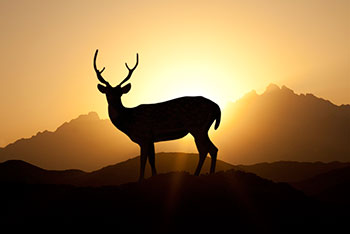 Oct. 16, 2014 – A three-judge panel for the U.S. Court of Appeals for the Seventh Circuit has issued a ruling in favor of the Wisconsin Indian tribes seeking relief from a judgment upholding a Wisconsin law that banned them from hunting deer at night.
Oct. 16, 2014 – A three-judge panel for the U.S. Court of Appeals for the Seventh Circuit has issued a ruling in favor of the Wisconsin Indian tribes seeking relief from a judgment upholding a Wisconsin law that banned them from hunting deer at night.
In 1991, a number of Indian tribes challenged a several regulations, including one that prohibited them from “shining” deer as a hunting method. At the time, Wisconsin argued that night hunting with lights was a safety concern. The court upheld the regulation.
In 2012, the Indian tribes filed a motion to reopen and modify the 1991 judgment, which is allowed under federal rules if enforcement of the judgment is “no longer equitable.”
Judge Barbara Crabb of the U.S. District Court for the Western District of Wisconsin denied the motion, rejecting the tribes’ claim that safety is no longer a concern.
But in Lac Courte Oreilles Band of Lake Superior Chippewa Indians of Wisconsin et al. v. State of Wisconsin, No. 14-1051 (Oct. 9, 2014), the three-judge panel vacated Judge Crabb’s ruling and remanded the case, noting evidence that supports the tribes’ claims.
In his opinion, Judge Richard Posner explained that under treaty, tribes can hunt outside reservation lands that were ceded by the tribes to the United States.
States can regulate tribal hunting on those public lands to protect public safety, and that was the justification for the night hunting regulation that was upheld in 1991. Since then, however, the evidence suggests that hunting deer at night is not really unsafe.
“All that can be said is that on the present record there is scant reason to think that safety concerns justify forbidding Indians to hunt deer at night in the thinly populated (by human beings) northern part of Wisconsin,” Judge Posner wrote.
The tribes noted that since 1991, the state engaged in deer hunting at night to control a skyrocketing deer population and to eradicate deer with chronic wasting disease. That experience showed that night hunting could be done safely, the tribes argued.
The district judge did not find this evidence compelling because the night hunting was done by employees or contractors of state government, not the tribes. But Judge Posner noted that Indian tribes also have hunting regulations and are safe hunters.
“Indians who hunt deer tend to be experienced hunters, because on their reservations they are allowed to hunt both during the day and at night,” Posner wrote. “Moreover, to be licensed to hunt they are required to pass a marksmanship test – at night.”
Posner said only two or three accidents involving Native Americans hunting in ceded territory have occurred in the last 25 years. In addition, Judge Posner noted that a very small Indian population places a “natural limit” on the risk” to public safety, and said any risk is mitigated by the fact that Indians must submit hunting plans to get permits.
“It’s true that at night the hunter may well have greater difficulty seeing a person in the woods behind the deer that he’s aiming at – and bullets fired from the high-powered rifles used to hunt deer carry a long way if they happen to miss the targeted deer.”
But in recognition of this danger,” Posner wrote, “the hunting regulations proposed by the tribes require the night-hunting Indians to lay out lines of sight in the daytime and submit a shooting plan for approval.” He noted that very few people are in those areas.
The opinion also suggests that continuing to ban the hunting of deer at night deer, when deer are most active, is unfair because many tribal members are poor and rely on deer to sustain themselves. Posner noted that lean venison is healthier than the high fat hamburger meat purchasable with food stamps that can contribute to health problems.
The panel remanded the case to the district court “for further proceedings consistent with this opinion,” which suggests the district court will lift the night hunting ban. Deer hunting season runs from November 1 until the first Monday in January every year.
